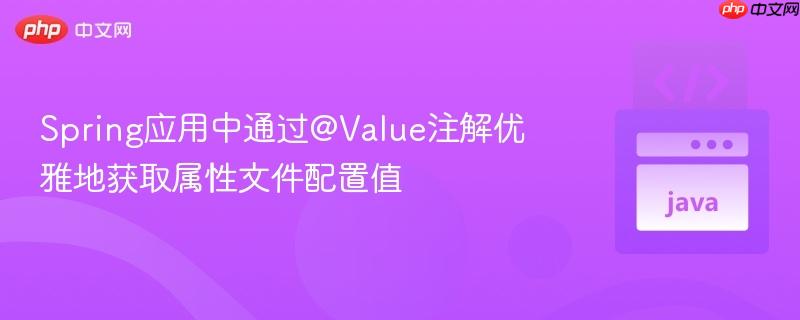
本教程详细介绍了如何在spring框架中,利用context:property-placeholder加载外部属性文件,并通过@value注解将配置值注入到spring管理的java bean中。文章将通过具体的代码示例,展示从定义属性文件、创建配置bean到在运行时代码中获取配置值的完整流程,旨在帮助开发者高效、灵活地管理应用程序的配置信息。
在Spring框架中,管理应用程序的配置信息是一项常见任务。尤其当配置值需要从外部属性文件(如.properties文件)中读取时,Spring提供了多种机制来简化这一过程。本文将聚焦于使用XML配置中的context:property-placeholder标签结合@Value注解,实现配置值的优雅注入。
首先,我们需要在Spring的配置文件(例如applicationContext.xml)中声明一个属性占位符配置器,告诉Spring去哪里寻找属性文件。context:property-placeholder标签是实现这一目的的便捷方式,它会注册一个PropertySourcesPlaceholderConfigurer(或旧版本中的PropertyPlaceholderConfigurer)Bean。
<!-- applicationContext.xml -->
<?xml version="1.0" encoding="UTF-8"?>
<beans xmlns="http://www.springframework.org/schema/beans"
xmlns:xsi="http://www.w3.org/2001/XMLSchema-instance"
xmlns:context="http://www.springframework.org/schema/context"
xsi:schemaLocation="http://www.springframework.org/schema/beans
http://www.springframework.org/schema/beans/spring-beans.xsd
http://www.springframework.org/schema/context
http://www.springframework.org/schema/context/spring-context.xsd">
<!-- 声明属性文件加载器,指定属性文件位置 -->
<context:property-placeholder location="classpath:myapp.properties" />
<!-- 其他Bean定义 -->
<!-- ... -->
</beans>上述配置中,location="classpath:myapp.properties"指示Spring在类路径下查找名为myapp.properties的属性文件。
接下来,创建实际的属性文件(例如src/main/resources/myapp.properties),并在其中定义需要读取的键值对。
# myapp.properties myservice.url=tcp://someservice:4002 myservice.queue=myqueue.service.txt.v1.q
这里我们定义了两个属性:myservice.url和myservice.queue。
为了将这些属性值注入到Java代码中,我们创建一个普通的Java类,并使用@Value注解来标记需要注入属性的字段。请注意,这个类必须由Spring容器进行管理,才能使@Value注解生效。
package my.app.util;
import org.springframework.beans.factory.annotation.Value;
import org.springframework.stereotype.Component; // 可选,用于组件扫描
/**
* 应用程序配置信息Bean
*/
public class ConfigInformation {
// 使用@Value注解注入myservice.url属性的值
// ${...} 语法指示Spring从属性源中解析占位符
@Value("${myservice.url}")
private String myServiceUrl;
// 使用@Value注解注入myservice.queue属性的值
@Value("${myservice.queue}")
private String myServiceQueue;
/**
* 无参构造函数。
* Spring在实例化Bean时可能需要,如果未显式提供,Java编译器会生成一个默认的。
*/
public ConfigInformation() {
// 可以在此处进行初始化逻辑,或留空
}
/**
* 获取服务URL。
* @return 服务URL字符串
*/
public String getMyServiceUrl() {
return myServiceUrl;
}
/**
* 获取服务队列名称。
* @return 服务队列名称字符串
*/
public String getMyServiceQueue() {
return myServiceQueue;
}
}在ConfigInformation类中,@Value("${myservice.url}")和@Value("${myservice.queue}")注解告诉Spring,在实例化这个Bean时,从已加载的属性文件中查找对应的键,并将其值注入到相应的字段中。
为了让ConfigInformation类成为一个Spring管理的Bean,我们需要在applicationContext.xml中对其进行声明。
<!-- applicationContext.xml (续) -->
<!-- ... -->
<!-- 注册ConfigInformation类为一个Spring Bean -->
<bean name="configInformation" class="my.app.util.ConfigInformation" />
</beans>通过
如果您的项目启用了组件扫描(通过
一旦ConfigInformation Bean被Spring容器初始化并注入了属性值,您就可以在应用程序的其他部分通过获取这个Bean来访问配置信息。
import org.springframework.web.context.WebApplicationContext;
import org.springframework.web.context.support.WebApplicationContextUtils;
import javax.faces.context.FacesContext; // 示例,根据实际应用环境调整获取ApplicationContext的方式
/**
* 示例服务消费者,演示如何获取并使用配置信息。
*/
public class MyServiceConsumer {
/**
* 执行使用配置信息的操作。
*/
public void doSomethingWithConfig() {
// 获取当前Web应用程序上下文
// 注意:这里的获取方式取决于您的应用环境。
// 例如,在Servlet环境下可以使用 request.getServletContext()。
// 如果是在另一个Spring管理的Bean中,通常会直接使用@Autowired注入ConfigInformation。
WebApplicationContext ctx = WebApplicationContextUtils.getWebApplicationContext(
FacesContext.getCurrentInstance().getExternalContext().getServletContext());
// 从Spring容器中获取ConfigInformation Bean
ConfigInformation configInfo = (ConfigInformation) ctx.getBean("configInformation");
// 现在可以访问注入的属性值
String serviceUrl = configInfo.getMyServiceUrl();
String serviceQueue = configInfo.getMyServiceQueue();
System.out.println("Service URL: " + serviceUrl);
System.out.println("Service Queue: " + serviceQueue);
// 使用这些配置值执行业务逻辑
// ...
}
}在上述代码中,我们首先获取了Spring的WebApplicationContext,然后通过Bean的名称"configInformation"获取到ConfigInformation实例。此实例中的myServiceUrl和myServiceQueue字段已经包含了从myapp.properties文件中读取到的值。
Bean必须由Spring管理:@Value注解仅对由Spring容器创建和管理的Bean有效。如果您尝试在一个非Spring管理的普通Java对象中使用@Value,它将不会被解析。确保您的类被@Component等注解标记并开启了组件扫描,或者通过XML的
静态方法与Environment:在原始问题中,尝试在静态方法中通过Environment.getProperty()获取属性值失败。这是因为context:property-placeholder(或其底层PropertySourcesPlaceholderConfigurer)是在Spring容器初始化后期,对Bean定义进行处理时才解析占位符的。在一个静态上下文中,可能无法访问到已完全初始化并处理了属性占位符的Environment实例,或者您获取的Environment对象尚未被增强以包含这些属性。推荐的做法是使用@Value注入到Spring管理的Bean中,或者通过@Autowired注入Environment对象到Spring Bean中再使用。
// 在Spring管理的Bean中可以这样使用Environment
import org.springframework.beans.factory.annotation.Autowired;
import org.springframework.core.env.Environment;
import org.springframework.stereotype.Component;
@Component
public class AnotherConfigReader {
@Autowired
private Environment env; // 注入Spring的Environment接口
public void printConfig() {
System.out.println("URL from Environment: " + env.getProperty("myservice.url"));
}
}多属性文件与优先级:如果需要加载多个属性文件,可以在location属性中使用逗号分隔(例如location="classpath:config1.properties,classpath:config2.properties"),或者使用通配符(如classpath*:*.properties)。当多个文件包含同名属性时,后加载的文件中的属性会覆盖前面文件的属性。
Spring Boot中的简化:对于Spring Boot应用,通常会使用application.properties或application.yml作为默认配置文件,并通过@PropertySource注解(用于加载非默认位置的属性文件)或@ConfigurationProperties注解结合@EnableConfigurationProperties来更便捷地管理配置,无需手动配置context:property-placeholder。例如:
// Spring Boot中使用@ConfigurationProperties
@Configuration
@ConfigurationProperties(prefix = "myservice")
public class MyServiceProperties {
private String url;
private String queue;
// ... getters and setters ...
}通过context:property-placeholder和@Value注解,Spring提供了一种强大且灵活的机制来外部化和管理应用程序的配置。这种方法将配置细节与业务逻辑解耦,提高了代码的可维护性和可部署性。理解其工作原理和适用场景,能帮助开发者构建更加健壮和适应性强的Spring应用。
以上就是Spring应用中通过@Value注解优雅地获取属性文件配置值的详细内容,更多请关注php中文网其它相关文章!

每个人都需要一台速度更快、更稳定的 PC。随着时间的推移,垃圾文件、旧注册表数据和不必要的后台进程会占用资源并降低性能。幸运的是,许多工具可以让 Windows 保持平稳运行。

Copyright 2014-2025 https://www.php.cn/ All Rights Reserved | php.cn | 湘ICP备2023035733号